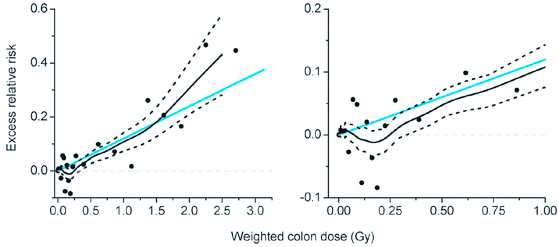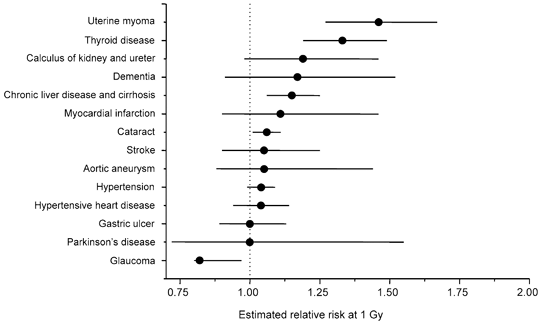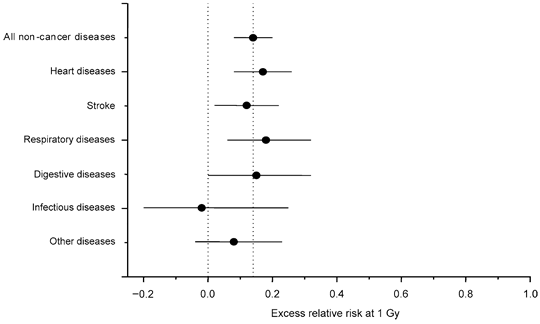Deaths Due to Non-cancer Disease
Analyses of the Life Span Study (LSS) mortality data (1950-1997) show a statistically significant dose-response pattern for death from diseases other than cancer. The excess does not seem limited to any particular disease. Among the 49,114 LSS survivors with colon doses of at least 0.005 Gy (DS86), 18,049 non-cancer deaths occurred (excluding deaths attributed to diseases of the blood). Circulatory diseases account for nearly 60% of these deaths, with digestive diseases, including liver diseases, and respiratory diseases accounting for about 15% and 10%, respectively.
Aside from diseases of the blood, the number of excess non-cancer deaths associated with A-bomb exposure is estimated at 150 to 300 cases. The death rate following exposure to 0.2 Gy (the mean radiation dose for the 49,114 survivors with doses >0.005 Gy) is increased by about 3% over normal rates. This is less than the death rate increase for solid cancers, where corresponding increases are 7% in men and 12% in women (age 30 ATB). The dose-response pattern is still quite uncertain (Figure 1).

Figure 1. Non-cancer dose-response function for the period 1968-1997 (DS86). The solid straight line indicates the fitted linear ERR model without any effect modification by age at exposure, sex or attained age. The points are dose category-specific ERR estimates, the solid curve is a smoothed estimate derived from the points, and the dashed lines indicate upper and lower one-standard-error bounds on the smoothed estimate. The right panel shows the low-dose portion of the dose-response function in more detail.
A significant radiation dose-response pattern was also seen for non-cancer blood diseases. Such diseases were studied separately since they may represent various hematologic malignant or premalignant conditions. Among the 128 deaths for which medical records were available and in which hematologic reviews were performed, about 45% were clearly classified as non-neoplastic blood diseases, 6% were diagnosed as leukemia or other hematopoietic cancers, and the remainder were potentially preneoplastic.
In the absence of known biological mechanisms, it is important to consider whether these results might be due to biases or to diagnostic misclassification of cancer deaths. Investigations have suggested that neither of these factors can fully explain the findings, especially for circulatory diseases that have been investigated more fully.
The Adult Health Study(AHS) incidence studies of non-cancer diseases show relationships with A-bomb dose for benign uterine tumors, thyroid disease (e.g., thyroid nodules), chronic liver disease, cataract, and hypertension (Figure 2). The LSS mortality data also show dose-related excesses for respiratory diseases, stroke, and heart diseases (Figure 3).

Figure 2. Relative risk for AHS incidence of non-cancer diseases at 1 Gy exposure (1958-1998)

Figure 3. Excess risk of mortality in the LSS due to non-cancer diseases. The increase is statistically significant for all non-cancer diseases, or specifically heart diseases, stroke, respiratory diseases, and digestive diseases. The horizontal bars indicate 90% confidence intervals.
Although the LSS data on heart disease mortality suggest that radiation is associated mainly with hypertensive and congestive heart disease, AHS data also suggest an association with myocardial infarction, as well as with a measure of atherosclerosis (aortic arch calcification). There is particular evidence, therefore, from both AHS clinical data and LSS mortality studies, that the rates of cardiovascular disease are increased in A-bomb survivors, especially, it appears, for persons exposed at young ages. Studies regarding possible underlying biological mechanisms are being conducted.

